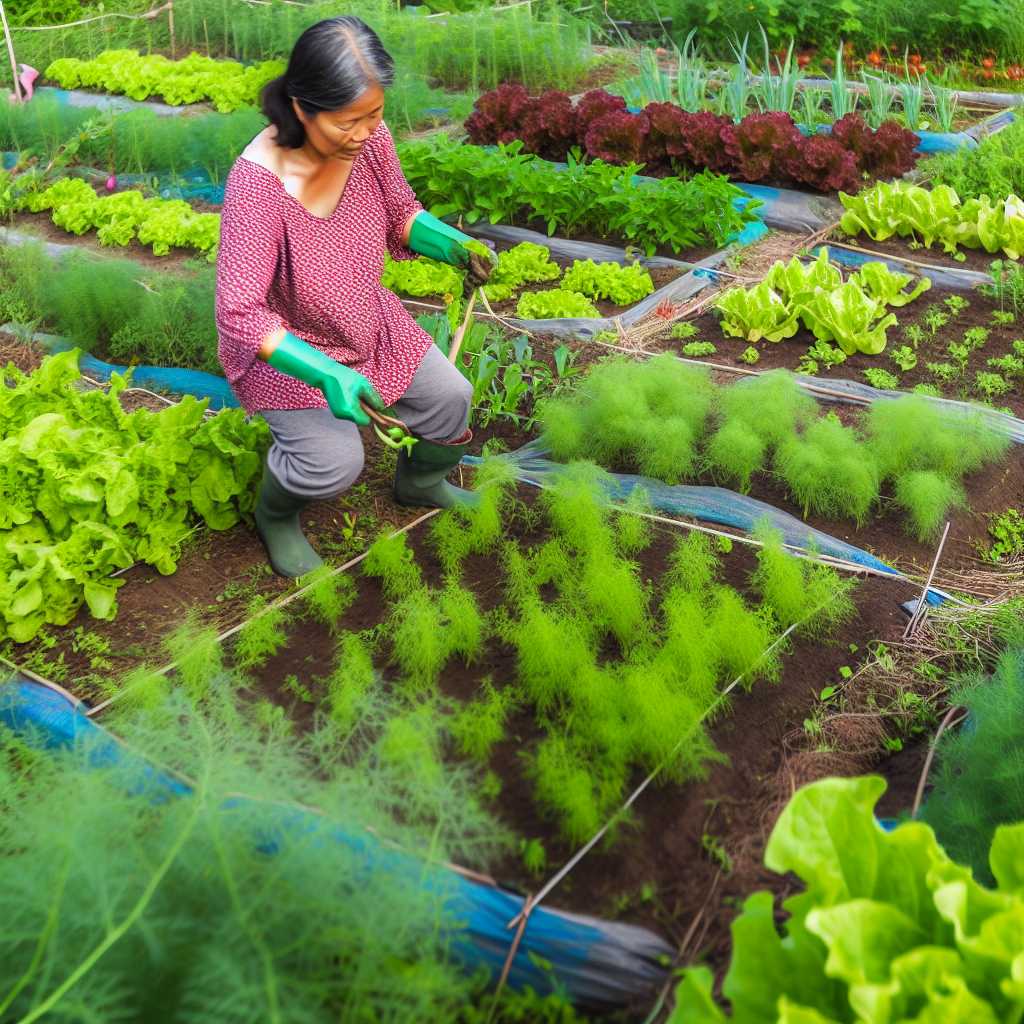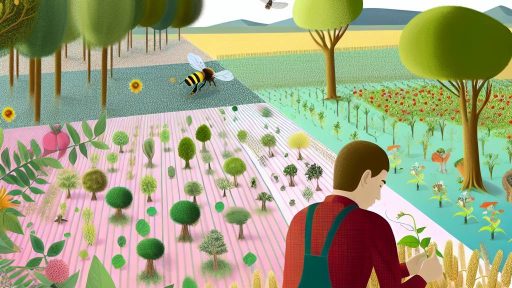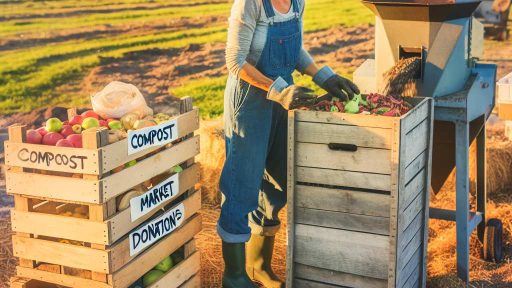Introduction to Permaculture Principles in Crop Rotation
Foundation of Permaculture
Permaculture focuses on sustainable agricultural practices.
It emphasizes working with nature, not against it.
This method builds healthy ecosystems over time.
A sustainable approach leads to productive farming systems.
Importance of Crop Rotation
Crop rotation enhances soil health and fertility.
It disrupts pest and disease cycles effectively.
Additionally, rotating crops diversifies the ecosystem.
This strategy minimizes the need for chemical inputs.
Consequently, it fosters a balanced environment for plants.
Design Principles in Permaculture
Permaculture employs design principles to maximize yields.
These principles focus on efficient use of resources.
They involve observing natural patterns in ecosystems.
Understanding these patterns aids in better crop arrangements.
Integrating Permaculture with Crop Rotation
Integrating permaculture with crop rotation enhances productivity.
It allows farmers to utilize diverse plant species harmoniously.
Transform Your Agribusiness
Unlock your farm's potential with expert advice tailored to your needs. Get actionable steps that drive real results.
Get StartedThis integration supports soil rejuvenation and nutrient cycling.
Moreover, it promotes a resilient agricultural system.
Steps to Implementing Permaculture Practices
First, assess the land’s natural features and resources.
Next, plan a rotation schedule based on crop needs.
Include legumes to enrich soil nitrogen levels.
Furthermore, incorporate cover crops in the off-season.
This practice protects soil and combats erosion.
Benefits of Using Permaculture in Crop Rotation
Adopting permaculture practices leads to improved biodiversity.
It enhances the resilience of the farming system.
Farmers experience more robust yields over time.
Additionally, it reduces dependency on chemical fertilizers.
Finally, permaculture cultivates a deeper connection to land.
Benefits of Organic Crop Rotation within Permaculture Systems
Enhanced Soil Fertility
Organic crop rotation significantly enhances soil fertility.
It allows for natural replenishment of nutrients in the soil.
Different crops contribute unique organic matter through their root systems.
As a result, beneficial microorganisms thrive and improve soil structure.
Pest and Disease Management
Crop rotation disrupts pest and disease cycles effectively.
Changing crops in a sequence prevents the buildup of harmful organisms.
This practice reduces the need for chemical pesticides.
Healthy plant diversity contributes to a balanced ecosystem.
Improved Biodiversity
Organic crop rotation promotes greater biodiversity on the farm.
Diverse crops attract various beneficial insects and wildlife.
Increased diversity enhances resilience against environmental stressors.
Moreover, it contributes to habitat creation for local fauna.
Showcase Your Farming Business
Publish your professional farming services profile on our blog for a one-time fee of $200 and reach a dedicated audience of farmers and agribusiness owners.
Publish Your ProfileWater Management
Effective crop rotation helps in better water management.
Diverse root systems improve soil infiltration and water retention.
This leads to reduced erosion and runoff during rainfall.
Consequently, it promotes sustainable water use in farming systems.
Economic Benefits
Implementing crop rotation can lead to lower input costs.
Farmers can reduce their reliance on fertilizers and pesticides.
This strategy often results in higher yields and better crop quality.
In turn, it enhances profitability for farmers practicing permaculture.
Designing a Permaculture Layout for Crop Rotation
Understanding Permaculture Principles
Permaculture focuses on working with nature rather than against it.
It promotes systems that are ecologically sustainable and self-sufficient.
Key principles include observation, diversity, and interaction among plants.
Assessing Your Site
Begin by evaluating your land’s characteristics.
Consider the climate, soil quality, and existing vegetation.
This assessment informs your layout decisions.
Analyze sunlight exposure and water drainage patterns.
Creating Zones for Crop Rotation
Establish zones to optimize crop rotation.
Zone one should include highly productive crops for frequent harvesting.
Zone two can accommodate semi-perennial plants.
Outer zones may host trees or perennial beds.
Selecting Companion Plants
Choose companion plants to enhance crop growth.
These plants can provide benefits like pest control and nutrient enhancement.
Examples include marigolds with tomatoes or legumes with grains.
Implementing Crop Rotation Techniques
Rotate crops to prevent soil nutrient depletion.
Practice three or more year rotations to optimize inputs and yields.
Utilize a mix of deep-rooted and shallow-rooted plants to improve soil structure.
Incorporating Cover Crops
Integrate cover crops into your rotation system.
These crops protect soil, prevent erosion, and improve fertility.
Legumes can fix nitrogen, benefiting subsequent crops.
Monitoring and Adjusting Your Layout
Regularly assess the health of your crops and soil.
Take note of what works well and what needs adjustments.
Be flexible and willing to modify your layout as needed.
Continuous observation leads to improved practices over time.
See Related Content: Urban Farming and Vertical Gardening for Maximum Space Utilization
Selecting Companion Plants for Enhanced Soil Health
Understanding Companion Planting
Companion planting boosts soil health through natural relationships between plants.
This method enhances nutrient availability and pest management.
By strategically selecting plants, farmers can support biodiversity in their fields.
Benefits of Companion Plants
Companion plants improve soil structure and fertility.
Certain plants encourage beneficial insects and repel harmful pests.
Moreover, they can fix nitrogen in the soil, enriching the nutrient profile.
Types of Companion Plants
Selecting the right companion plants is crucial for successful outcomes.
Showcase Your Farming Business
Publish your professional farming services profile on our blog for a one-time fee of $200 and reach a dedicated audience of farmers and agribusiness owners.
Publish Your Profile- Legumes, such as peas and beans, increase nitrogen levels.
- Herbs like basil and mint repel unwanted insects effectively.
- Flowering plants, such as marigolds, attract pollinators to the garden.
Creating Effective Combinations
Use combinations that complement each other’s growth requirements.
Grouping plants with similar watering and sunlight needs yields better results.
For instance, pairing tomatoes with basil enhances their growth and flavor.
Implementation and Maintenance
Establish companion plants at the beginning of the growing season.
Monitor their development to ensure healthy interactions are maintained.
Regularly removing weeds will prevent nutrient competition.
Real-World Examples
The Three Sisters method showcases a traditional companion planting technique.
This system includes corn, beans, and squash growing harmoniously.
In this symbiotic relationship, each plant supports the others’ growth.
Uncover the Details: Farm-To-Table Pop-Ups for Direct Farmer-to-Chef Ingredient Sourcing
Implementing Seasonal Crop Changes for Biodiversity
Understanding Crop Rotation
Crop rotation refers to the practice of growing different crops in the same area sequentially.
This process helps improve soil health and prevents pest buildup.
It enhances biodiversity and reduces reliance on chemical inputs.
Benefits of Diverse Cropping
Diverse cropping systems increase resilience to pests and diseases.
They also result in improved soil structure and nutrient availability.
This practice promotes a balanced ecosystem within the farming environment.
Seasonal Considerations
Farmers must assess seasonal patterns and local climate conditions.
Choosing the right crops for each season maximizes productivity.
Moreover, planting cover crops during off-seasons helps prevent soil erosion.
Selecting Compatible Crops
Some crops can benefit from their neighbors, enhancing overall yield.
For example, planting legumes can fix nitrogen in the soil, benefiting nearby crops.
Researching compatible species creates effective planting combinations.
Implementing Methodologies
Start by planning your crop rotation schedule on a yearly basis.
Incorporate different crop families to disrupt pest and disease cycles.
Documenting changes each season helps identify successful practices.
Monitoring and Adjusting Practices
Continuous monitoring of crop performance is essential for success.
Look for signs of nutrient deficiency or pest issues regularly.
Adjust practices based on observed results and seasonal changes.
Community Engagement
Engaging with local farmer communities enhances knowledge sharing.
Participating in workshops can provide new insights on crop rotation.
Building a network of organic farmers creates a support system for best practices.
Discover More: Farm Fresh Delivery Services for Community Supported Agriculture

Soil Management Techniques in Permaculture Crop Rotation
Understanding Soil Health
Soy health is vital for successful permaculture systems.
Healthy soil supports robust plant growth and biodiversity.
It relies on a balance of nutrients, moisture, and microbial life.
Enhancing Soil Fertility
Using cover crops improves soil fertility significantly.
They prevent erosion while adding organic matter back to the soil.
Moreover, they can fix nitrogen, enriching the soil naturally.
Implementing Crop Diversity
Diversifying crops helps to prevent pests and diseases.
Different plants promote unique interactions in the soil.
Showcase Your Farming Business
Publish your professional farming services profile on our blog for a one-time fee of $200 and reach a dedicated audience of farmers and agribusiness owners.
Publish Your ProfileThus, intercropping can result in healthier crops.
Practicing No-Till Farming
No-till farming reduces soil compaction and maintains structure.
This practice allows beneficial organisms to thrive unharmed.
Further, it conserves moisture and prevents erosion.
Utilizing Composting Wisely
Composting recycles organic waste back into the soil.
This method enhances soil fertility and structure simultaneously.
Furthermore, compost improves moisture retention significantly.
Emphasizing Mulching
Mulching protects soil from erosion and temperature fluctuations.
It also suppresses weeds, providing more resources for crops.
Organic mulches enhance soil fertility as they decompose over time.
Monitoring Soil Health Regularly
Routine soil testing helps assess nutrient levels and pH balance.
This practice ensures adjustments are made based on soil needs.
Regular monitoring promotes sustainable soil management strategies.
Learn More: Farm Fresh Delivery Services for Locally Sourced Produce
Pest Control Strategies using Permaculture Methods
Understanding Pest Dynamics
Pest management begins with recognizing pest behaviors.
Analyzing pest life cycles allows effective intervention.
Every crop has its specific pests and needs tailored responses.
Beneficial insects play a role in regulating pest populations.
Promoting Biodiversity
Diverse planting supports natural pest control mechanisms.
Implementing companion planting can confuse harmful insects.
Planting a variety of species attracts beneficial predators.
Additionally, diversity increases resilience in the ecosystem.
Use of Natural Predators
Encouraging natural predators limits pest outbreaks.
Birds, ladybugs, and lacewings can effectively manage pests.
Building birdhouses can attract insectivorous birds.
Furthermore, planting nectar-rich flowers can enhance predator populations.
Mechanical Pest Control Methods
Handpicking pests is an effective and immediate solution.
Using barriers like row covers may prevent insect access.
Traps can help monitor and control pest populations.
Employing sticky traps provides a visual cue for pest pressure.
Organic Amendments and Deterrents
Utilizing organic matter can improve soil health and pest resistance.
Applying neem oil or insecticidal soap can deter pests organically.
Planting herbs such as basil and mint can repel unwanted insects.
Essential oils serve as effective natural repellents as well.
Crop Rotation and Planning
Implementing crop rotation disrupts pest life cycles.
Different plant families can prevent pest establishment.
Planning planting schedules also helps minimize pest outbreaks.
Monitoring soil health will support long-term pest management.
Evaluating Crop Yields and Soil Fertility in Rotational Systems
Understanding Crop Yields
Crop yields reflect the effectiveness of farming practices.
To evaluate yields, farmers collect data each season.
Showcase Your Farming Business
Publish your professional farming services profile on our blog for a one-time fee of $200 and reach a dedicated audience of farmers and agribusiness owners.
Publish Your ProfileThis data highlights trends and informs future decisions.
Moreover, comparing yields across different crop types provides insights.
Healthy crop rotations often lead to improved yields.
Assessing Soil Fertility
Soy fertility plays a critical role in crop productivity.
Healthy soil contains essential nutrients required for growth.
Farmers can assess soil fertility through regular testing.
Soil tests reveal nutrient levels and pH balance.
This information helps tailor amendments for optimal health.
Benefits of Crop Rotation
Crop rotation significantly improves soil quality.
Diverse crops contribute to better nutrient cycling.
This practice also helps disrupt pest and disease cycles.
Farmers notice increased yields and healthier soils over time.
Integrating Permaculture Principles
Permaculture principles enhance rotational systems effectively.
These principles focus on sustainability and ecological balance.
Incorporating perennials can support soil structure and health.
Additionally, promoting biodiversity creates resilient ecosystems.
Farmers can utilize companion planting to maximize space.
Monitoring and Adjusting Practices
Continuous monitoring of crop performance is vital.
Adjusting practices based on data ensures ongoing improvements.
Farmers should maintain detailed journals of crop rotation results.
This record-keeping allows for informed decision-making.
Lastly, collaborating with local agricultural experts can provide valuable insights.
Additional Resources
What is Syntropic Farming?: A Permaculture Perspective — Porvenir …




